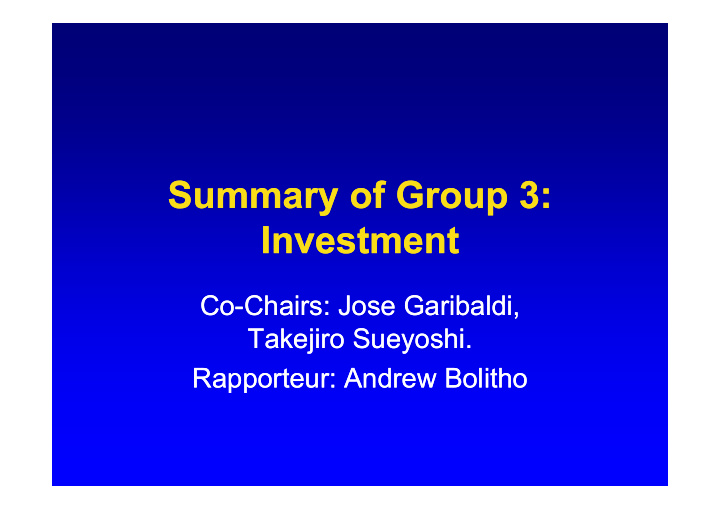



Co Co-Chairs: Jose Garibaldi, Co Co-Chairs: Jose Garibaldi, Chairs: Jose Garibaldi, Chairs: Jose Garibaldi, Takejiro Sueyoshi. Takejiro Sueyoshi. Rapporteur: Andrew Bolitho Rapporteur: Andrew Bolitho Rapporteur: Andrew Bolitho Rapporteur: Andrew Bolitho
• Achieving a low-carbon society is fundamentally a question of re- directing investment to more energy efficient and having lower carbon intensity technologies, techniques and infrastructure. carbon intensity technologies, techniques and infrastructure. • Embedded Investment: will affect carbon intensity for decades – every investment made without considering carbon intensity a every investment made without considering carbon intensity a missed opportunity. • • Investment path shift: focus beyond incremental improvements, to Investment path shift: focus beyond incremental improvements, to the timescale and the size of change required
Additional investment and financial flows in 2030 Mitigation Sector Global Share of developing countries countries (billion USD) (billion USD) Energy Supply (-) 67 55% Industry Industry 36 36 53% 53% Building 51 29% Waste Waste 0.9 0.9 67% 67% Transport 88 41% Agriculture Agriculture 35 35 66% 66% Forestry 21 99.5% Energy RD&D 35 - 45 - Global: 200 – 210 billion USD (0.92% of projected global investment and 0.26% of global GDP in 2030) Non Annex I Parties: 76 - 77 billion USD (0.86% of Investment and 0.29% of Non Annex I Parties: 76 - 77 billion USD (0.86% of Investment and 0.29% of GDP in 2030) Amount large in absolute terms, but small relative to GDP and total investment
Additional investment and financial flows Additional investment and financial flows Additional investment and financial flows - adaptation in 2030 Additional investment and financial flows - adaptation in 2030 adaptation in 2030 adaptation in 2030 Sector Sector Global Global Share of Share of developing developing (billion USD) (billion USD) countries countries Agriculture, forestry and Agriculture, forestry and 14 14 50% 50% fisheries fisheries Water supply Water supply Water supply Water supply 11 11 11 11 80% 80% 80% 80% Human Health Human Health 5 5 100% 100% Coastal zone Coastal zone Coastal zone Coastal zone 11 11 11 11 40% 40% 40% 40% 8 - - 130 Infrastructure Infrastructure 8 130 25% 25% Global Global Global: Overall Global: Overall Overall needs Overall needs needs identified needs identified identified in identified in in this in this this study this study study correspond study correspond correspond to correspond to to 0.2–0.8% of to 0.2–0.8% of of of global global investment investment flows flows or or 0.06 06-0 0.21 21 % % of of projected projected GDP GDP in in 2030 2030. Developing Developing Developing countries Developing countries countries: USD countries: USD USD 28 USD 28 28 to 28 to to 67 to 67 67 billion 67 billion billion in billion in in 2030 in 2030 2030. 2030. Amount Amount large large in in absolute absolute terms, terms, but but small small relative relative to to GDP GDP and and investment investment
• Low carbon intensive sector untapped: – need to direct investment in both high and low carbon intensive – need to direct investment in both high and low carbon intensive industries - wider range of low cost measures in the latter • • Range of Interventions: Range of Interventions: – basic information, – logistical and financial innovations to maximise the cumulative potential of individual actions, potential of individual actions, – regulation and programme based approaches to carbon finance when these are appropriate. – Carbon pricing – Carbon pricing • Frequent mismatches in companies between contribution to carbon emissions and associated carbon production costs emissions and associated carbon production costs – Carbon pricing capable of addressing mismatches, but not in appropriate time scale – Carbon management at appropriate scale and time requires – Carbon management at appropriate scale and time requires measures to accompany entry of emissions trading.
• Increase R&D in new LCS technologies and techniques required • • Urgent need to increase investment in the deployment of already Urgent need to increase investment in the deployment of already existing low-carbon technologies. • • unique barriers in each of the major contributors to the technology unique barriers in each of the major contributors to the technology options to LCS -need to be addressed in an integrated fashion for investment to flow. • Credible Government actions for a robust carbon price signal necessary but not on their own sufficient.
• • Reduction opportunities frequently less expensive on a per tonne Reduction opportunities frequently less expensive on a per tonne basis in the developing world. – International cooperation to facilitate appropriate measures that – International cooperation to facilitate appropriate measures that encourage scaling up of investment. – Cooperation to extract these reductions increase global benefits. • Delaying the implementation of actions on a domestic and global perspective – Significantly increase costs of achieving a low-carbon society, – Measures implemented in a shorter and more expensive timeframe, timeframe, – Costs currently not associated with Climate Change impacts increments.
Recommend
More recommend